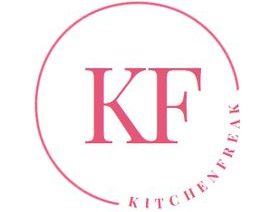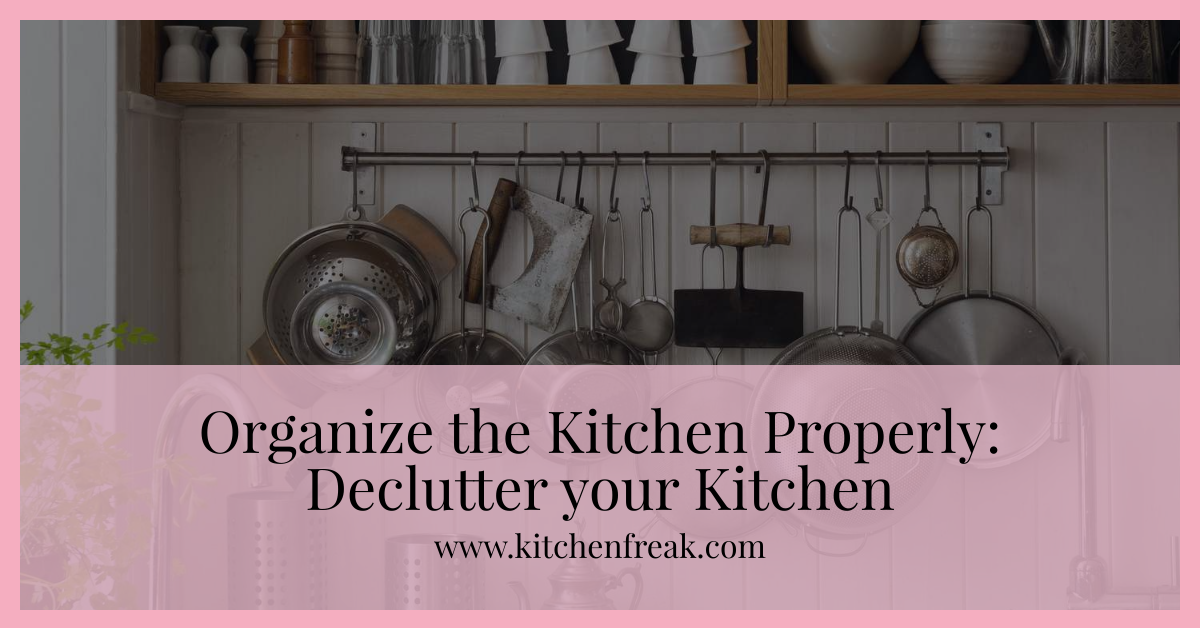Is your kitchen a problem area?
Who knows, maybe there are just a few things out of place.
We’ll show you how to properly declutter your kitchen and give everything a meaningful place – from coffee spoons to food processors.
Table of Contents
Decluttering your kitchen
1. Cutlery and dishes
Store your daily cutlery and dishes as close to the sink or dishwasher as possible.
This means it is ready to hand and can be put away quickly. And the kitchen is quickly declutter again.
Rooms further away, like the dining room, are not a good idea. You may have set the table quickly, but after washing up it will take longer for everything to be put away again.
In the worst case scenario, dishes and cutlery for the dining room are “temporarily stored” in the kitchen until someone takes them away.
Find a place for everyday dishes and cutlery that makes cleanup easy. Equipment that you only take out on special days can safely go into the basement.
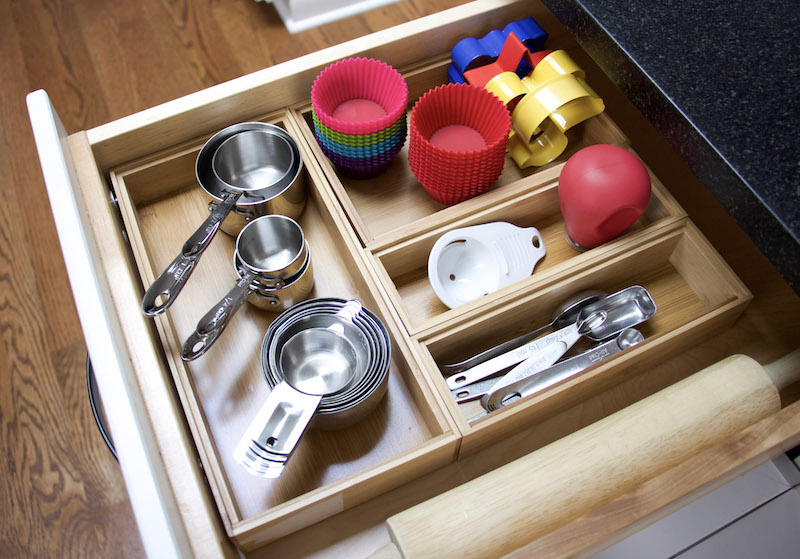
2. Pans, pots, kitchen utensils
It’s best to store anything you want to have quickly at hand while cooking around the stove. This way you don’t have to take your eyes off your food when you need something.
It is important to arrange everything clearly. This way you can easily see which pot or pan you are currently grabbing.
Tip! It’s best to check beforehand which pots and pans you use all the time and put them in a closet or compartment close to the stove.
Hanging it up is also a good choice; hooks or a pot rack are recommended.
You can give cooking tools that you use less a place where they don’t get in the way.

3. Spices and sauces
Salt, pepper, vinegar, oil, sauces – everyone has ingredients that they constantly need for cooking.
You don’t want to have to go through the hassle of getting these somewhere, especially not when the food is already sizzling!
Good places for everyday spices and ingredients are the kitchen cabinets and closets to the right and left of the stove. They are quickly taken out and put away again.
And nothing is standing around.

4. Knives
When it comes to knives, it is less important WHERE you store them than HOW you store them – namely as safely as possible.
It’s best to keep them in a knife block; it’s more space-saving with a magnetic strip on the wall.
If neither is available, you can also store your knives in a closet.
It is important that they are easy to see and that you do not have to laboriously rummage through the closet.
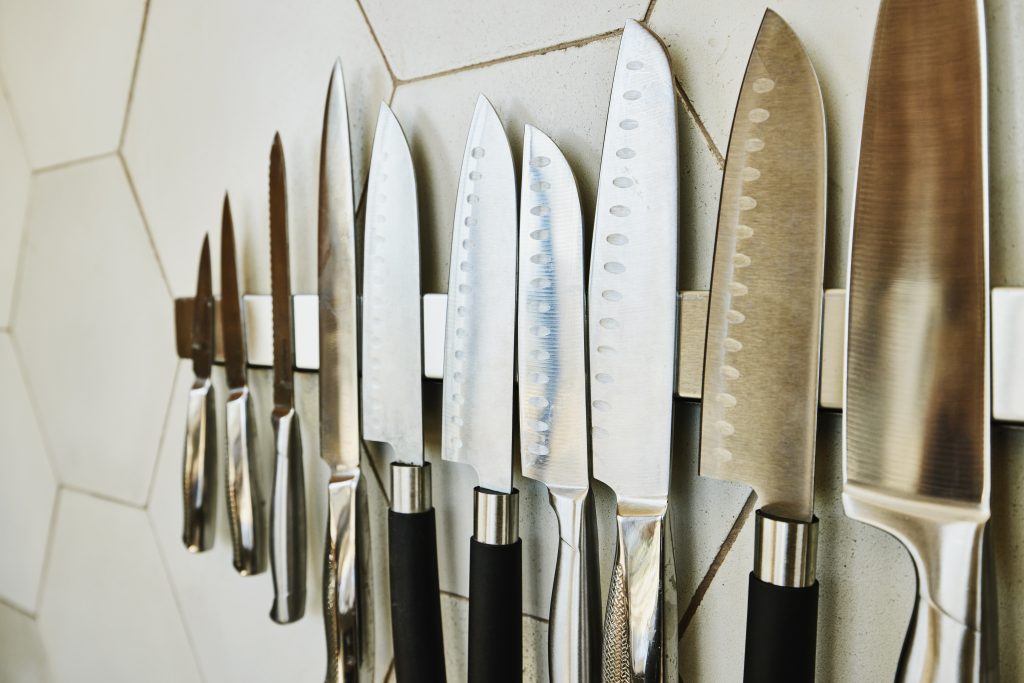
5. Bowls, tuppers and co.
There are various places for bowls, one of which is on the refrigerator, for example, where you can pack your supplies or prepare salad.
You should avoid putting Tupperware etc. on the upper shelves.
Because plastic bowls have a habit of getting stuck and then coming out all together even though you’ve actually only pulled one of them.
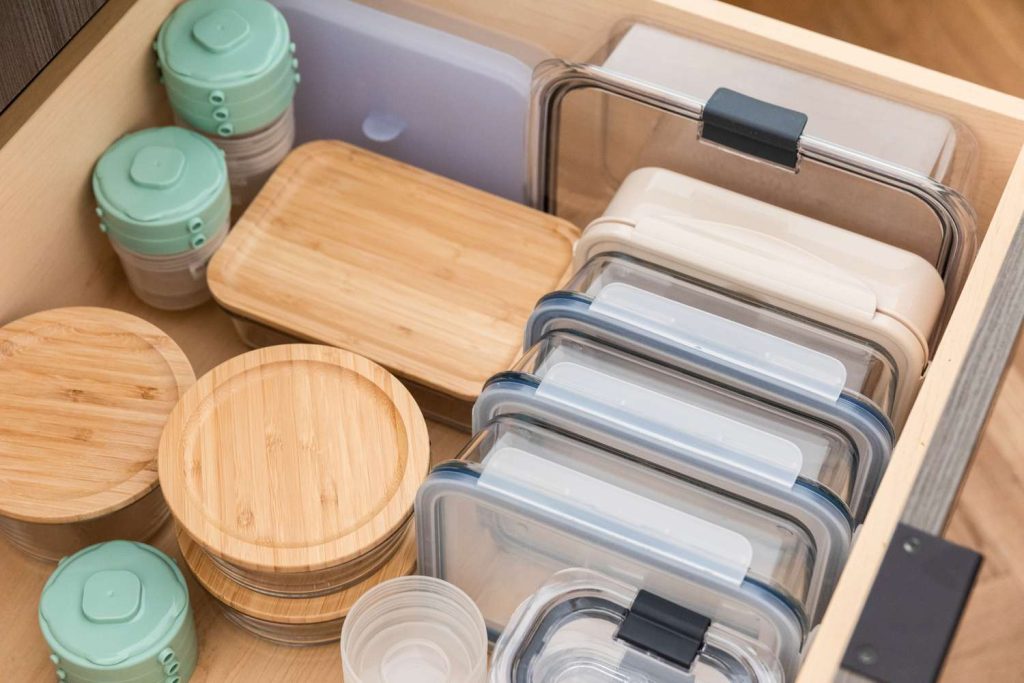
6. Electric kitchen devices
There is no patent recipe for small kitchen devices – because how we use toasters, kettles, hand blenders etc. is completely different.
It is important that you do not allow any kitchen appliance to take up unnecessary space on your work surface.
Think carefully about what you need every day and only leave things on the counter that are in use every day. Everything else can disappear into drawers and kitchen cupboards.
Tip! Most microwaves can be hung up – this frees up space on the worktop and helps in decluttering.
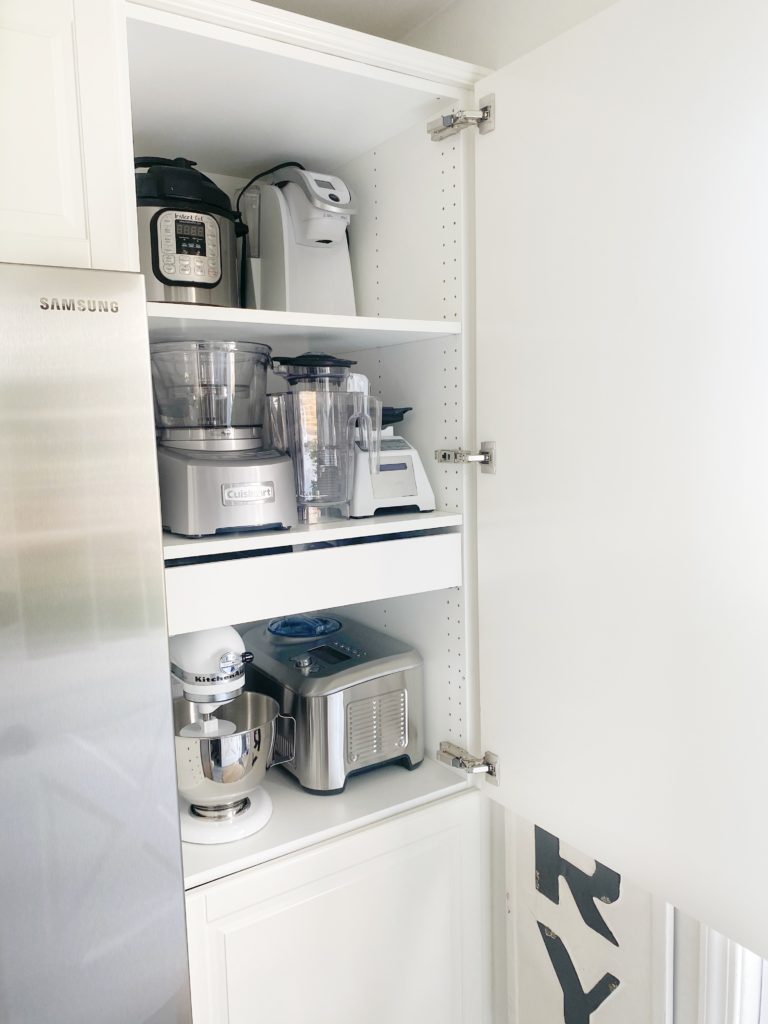
7. Food
If you want to properly tidy up your kitchen, you also need a place for food.
And not for those in the refrigerator, but for the supplies that can be stored without refrigeration – for example canned goods, rice or pasta.
Where you store these foods depends entirely on the spatial conditions.
Basically, it is advisable to keep supplies out of the kitchen cupboards if possible and rather store them in a pantry or pantry. This keeps the kitchen clearer and tidier.
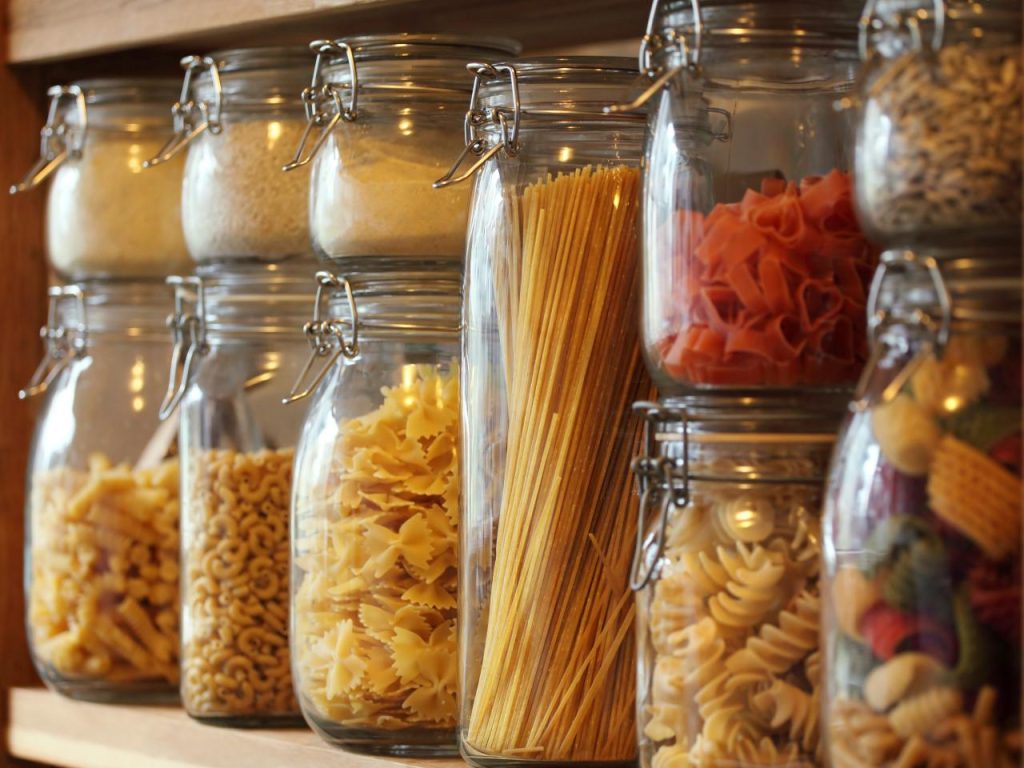
8. Important: The junk drawer
Even if some tidying fans don’t like to see them – the junk closet belongs in every household. Because we all have things that we don’t know where to put them.
Our recommendation: Organize the junk closet with small compartments to keep track of everything – and throw away anything you haven’t used in the last two years.
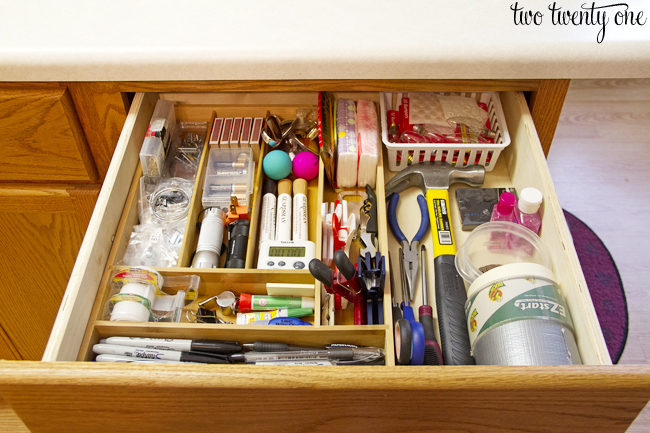
Declutter your kitchen cupboards properly
Whatever you need in the kitchen, clutter it in the kitchen closets when not in use. But over the years they become more and more crowded and confusing. Eventually you forget what’s behind the closet doors and it takes longer to find the item you want. You will save time and effort if you organize the kitchen systematically and declutter the kitchen closets sensibly. You can find out how best to do this in this guide from The Modern Housewife.
How do you organize a kitchen?
To organize your kitchen ideally, it makes sense to focus on what you do in it every day. If you mentally go through the typical work processes, you can distinguish between five different work areas and kitchen zones:
- Stock up (food)
- Store
- Prepare
- Cooking baking
- Clean/dispose of
To save time and prevent unnecessary trips, it is advisable to organize the kitchen closets according to their intended use. This means that, for example, all the dishes you need for eating are in the same place. The same applies to kitchen devices, cookware and baking tools as well as food preparation and storage.
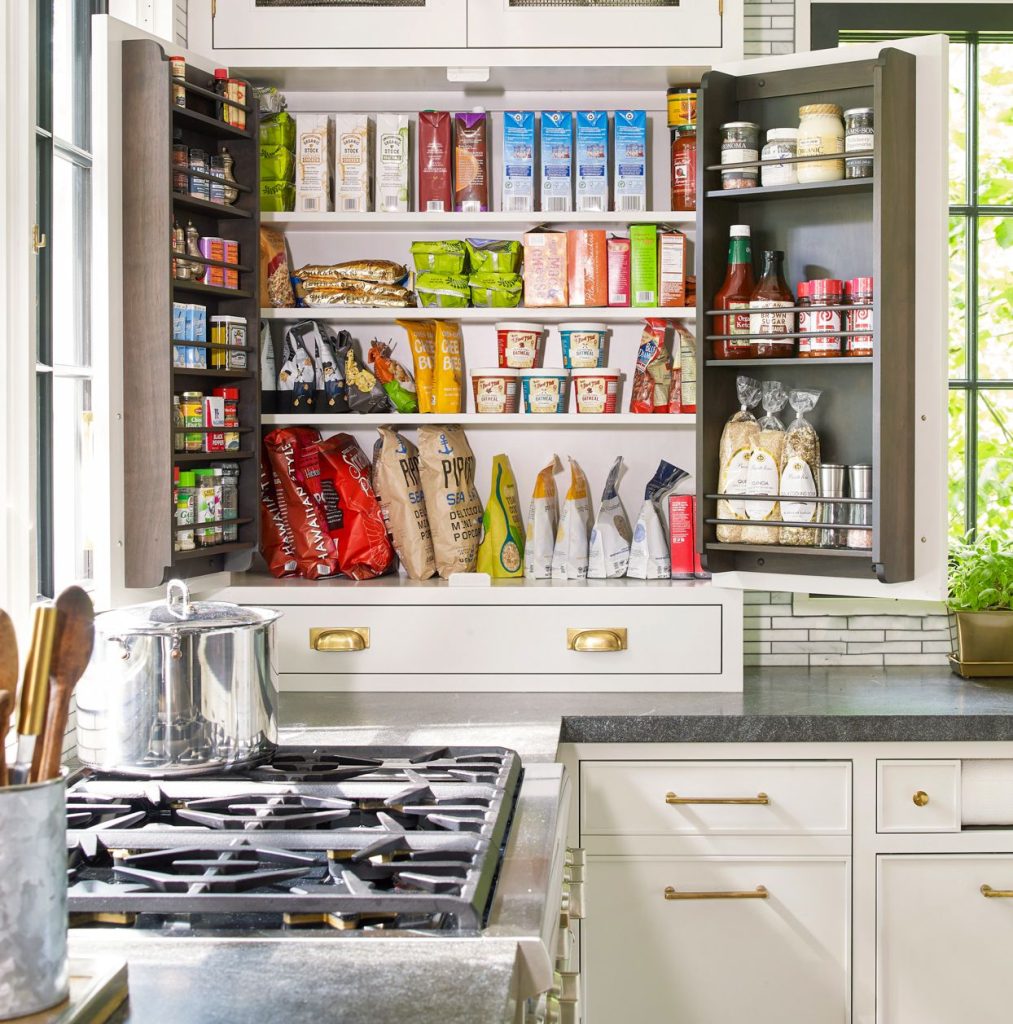
What goes into the kitchen cupboards?
Matching the kitchen zones mentioned, you can store everything you need for the respective work steps in the kitchen in the corresponding kitchen closets. These essentially include:
- Food (dry storage)
- Dishes, glasses and cups
- Kitchen devices and tools
- Utensils such as pots and pans
- Cleaning and cleaning accessories
Once you have sensibly put all of this into the kitchen closets, nothing stands in the way of working quickly and effectively in the kitchen in the truest sense of the word.
How to organize kitchen closets sensibly?
Depending on the work area, the system for the perfectly organized kitchen closet can vary slightly. That’s why the following tips are listed separately by work area.
Stock up (food)
The pantry contains all food that should be stored dry and at room temperature. These typically include pasta and rice, flour and sugar, coffee and tea as well as canned food and other long-life products such as condiments and instant products. Pull-out tall cabinets (“apothecary closets”) are particularly practical for storing dry supplies. Thanks to the pull-out closets, all foods in these closets are easily accessible, regardless of whether they are in the front or back. That’s why sorting the food is secondary here.
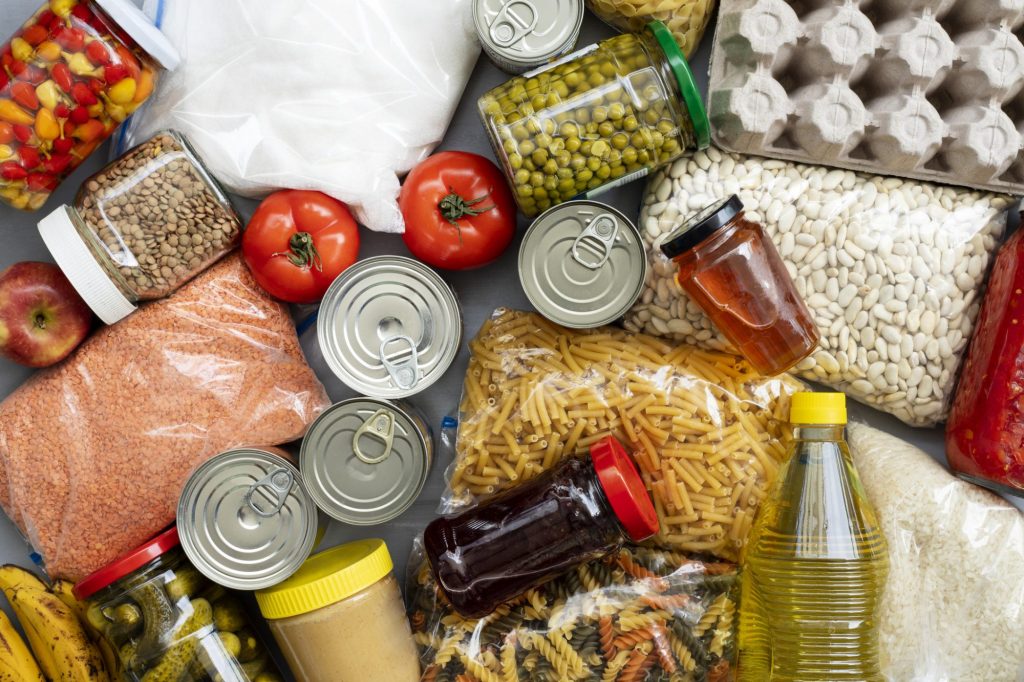
The situation is different with classic closets with hinged doors. Here only the groceries at the front are easily accessible. Further back they quickly disappear from view, are overlooked or forgotten and are also more difficult to retrieve. That’s why you should always sort these closets according to the “first things first” principle. In other words: put what you need frequently at the front and the supplies you use less frequently at the back. When stocking up your pantry, always sort by best-before date so that the products with the shortest shelf life are at the front.
Store
In this area you store dishes such as plates, bowls and casserole dishes, glasses and cups. But cutlery is also included in the broadest sense. Both upper and lower closets are suitable for storage. If you have the choice, choose base closets with pull-outs instead of closet doors. This means you don’t always have to bend down and you still have an overview of the entire contents of the closet.
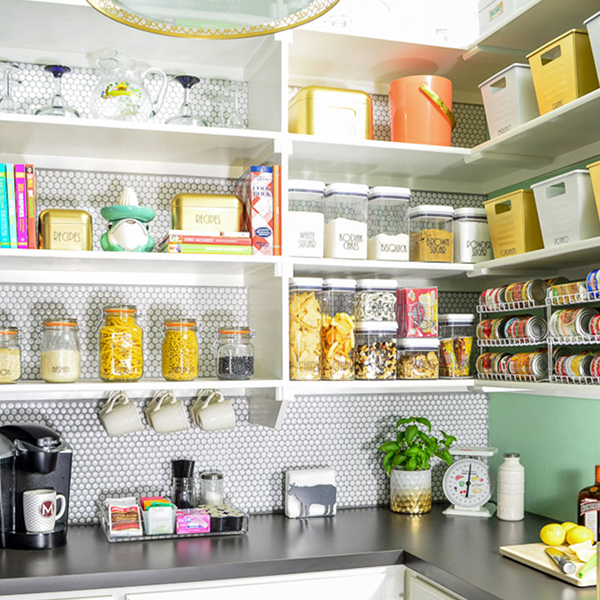
When sorting, you should be guided by the weight of the items: heavy dishes, bowls and casserole dishes belong in the lower cabinet, while glasses and mugs are better stored in the upper closet. Exception: Even if plastic bowls and other plastic containers are very light, it is better not to put them on the upper shelves. Because when they are stacked inside each other, they are difficult to separate up there.
Prepare
This work area is all about preparation for food preparation. In addition to the work surface, various kitchen devices and utensils are used. This includes cutting boards and knives, but also kitchen scales, can openers, blenders and many other small tools such as garlic press or cheese grater. To speed up and simplify work processes, it makes sense to put all these kitchen tools in one place.
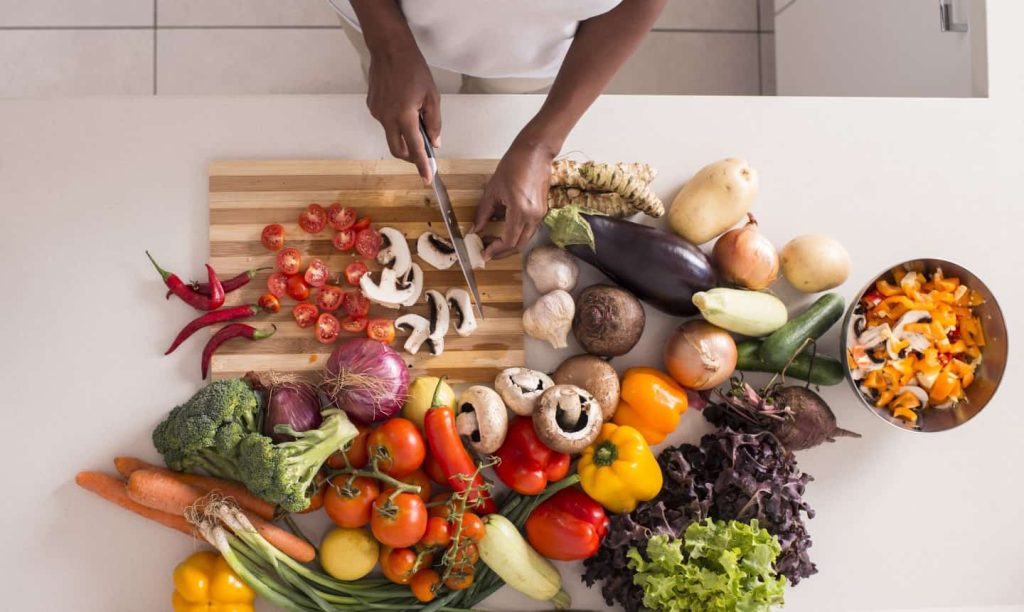
If possible, well sorted (and therefore quickly accessible) in a compartment. Knife holders and compartment inserts are suitable for this, as they prevent the drawer from becoming chaos after a short time. Especially when it comes to knives , make sure that they do not pose a danger in the drawer. A knife block or a magnetic strip on the wall is safer.
Tip: Wall brackets are a practical alternative where you can easily store various kitchen tools in a space-saving manner. Hanging shelves that you can hang from the ceiling are also suitable for very small kitchens.
Cooking baking
The central work area in the kitchen is the stove or oven. Other electrical appliances such as steamers or microwaves are placed around it. However, you don’t need all kitchen appliances equally often. Waffle irons, sandwich makers and electric grills are used comparatively rarely in most households. Here it often makes sense to store the kitchen appliances outside the kitchen (for example in the pantry or in the basement). This saves space in the long term and the longer route is reasonable for the few times you need the devices.
Tip: If you have a multifunctional device and use it regularly, it can usually replace some other individual devices. To save space, you can give these away or sell them at a flea market.
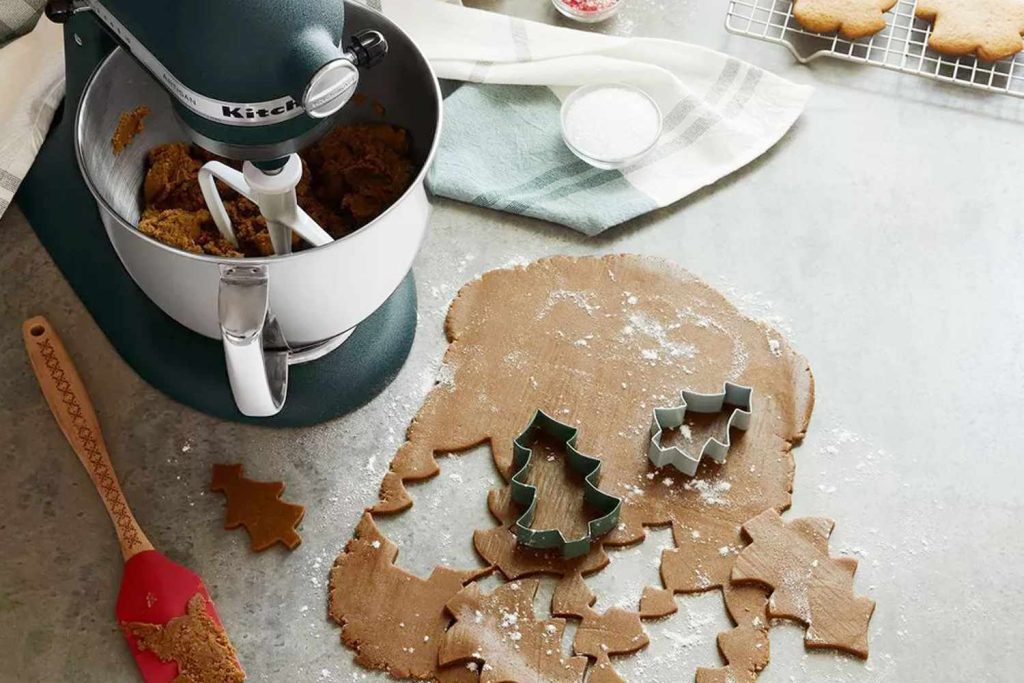
If everyday items such as pots and pans and cooking tools are placed near the stove and oven, you save time and travel. However, pot lids take up a lot of space in the closet because they can hardly be stacked. However, with a little skill you can easily hang them on the inside of the closet door using adhesive hooks.
Tip: If a small mishap happens, it is helpful to have kitchen paper handy. You can mount it on a stand nearby or as a roll on the wall. You should also have pot holders and tea towels within easy reach of the stove and oven – for example on a holder on a closet door.
Clean/dispose of
The focus of this work area is the sink, often adjacent to a dishwasher. The trash can is usually located under the sink – this organizing principle also follows the typical work processes: dirty dishes are first removed from the food residue, which, depending on their consistency, ends up in the trash can or is washed away, and then goes into the dishwasher. In addition to one or more trash cans, the space under the sink is traditionally reserved for cleaning and cleaning accessories. This includes accessories for the dishwasher (tabs, rinse aid, etc.) as well as general cleaning products for the kitchen.
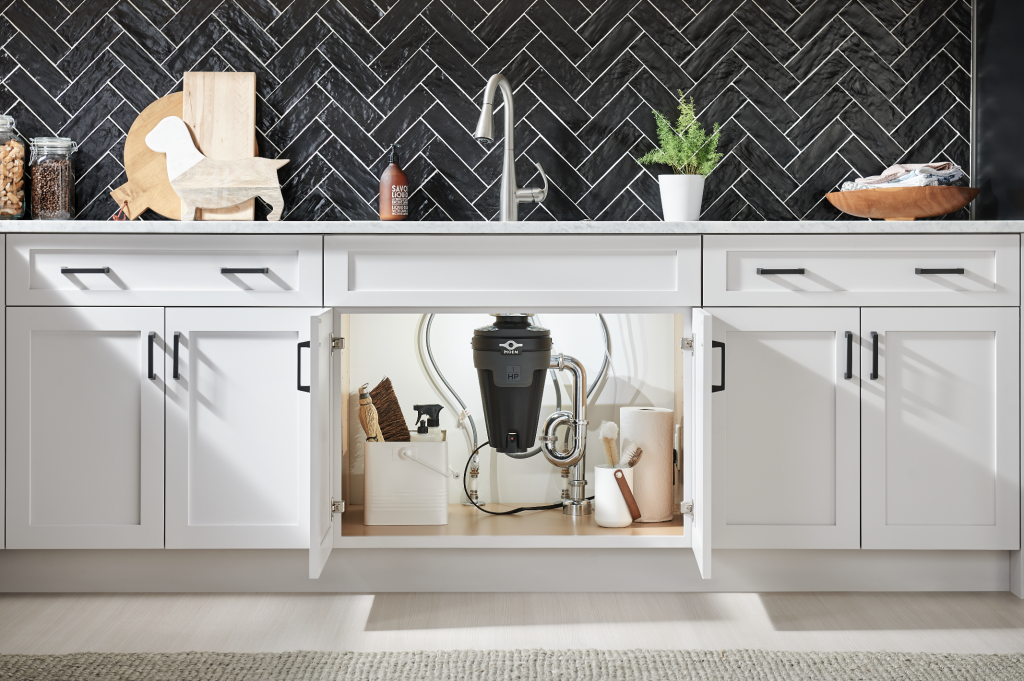
What can you put on kitchen cabinets?
Kitchen closets are often so high that you cannot easily reach the items on them. So that you don’t have to constantly stretch or get a stepladder, you should only store things here that you rarely use. Typical examples of this are cookie cutters for Christmas cookies, the roaster for the Christmas goose or the raclette grill, which is only used on New Year’s Eve.
Tip: Over time, a light film of grease forms on the kitchen closets, which often takes a lot of effort to remove. This grease film also covers everything you store on the closets. That’s why we recommend placing a piece of crepe paper or newspaper on the top of the closet and attaching it with some adhesive strips. On the other hand, it makes sense to only store things that are packaged or that are very easy to clean. In our example: it is better to store the cookie cutters in a cookie tin and place the roasting pan or raclette grill in the corresponding box on the closet.
Use these hacks to keep your kitchen tidy
Chaos with lids in the closet, too little storage space and a different hodgepodge in every corner? We’ll give you a few tips and ideas on how you can better organize your kitchen.
Where is the right spice for Thai curry and weren’t the potholders lying right here yesterday? Yes, yes, things can get really chaotic in the kitchen sometimes. If this annoys you, we have practical kitchen hacks that will put an end to the chaos.
Where to start when organizing your kitchen?!
If you want to start from scratch, you should clear everything out first. You can also use this opportunity to wipe out the closets. This is how you do it in the first step:
- When it comes to foods, sort out those that are definitely no longer edible.
- Sort your food according to frequency of use and best-before date.
- You also sort the items according to how often they are used and which ones are useless and can be thrown away!
You can donate the food and items that are still usable or edible but will not be used or consumed by you in the foreseeable future (e.g. exchange refrigerators) or give them away to friends, family or neighbors.
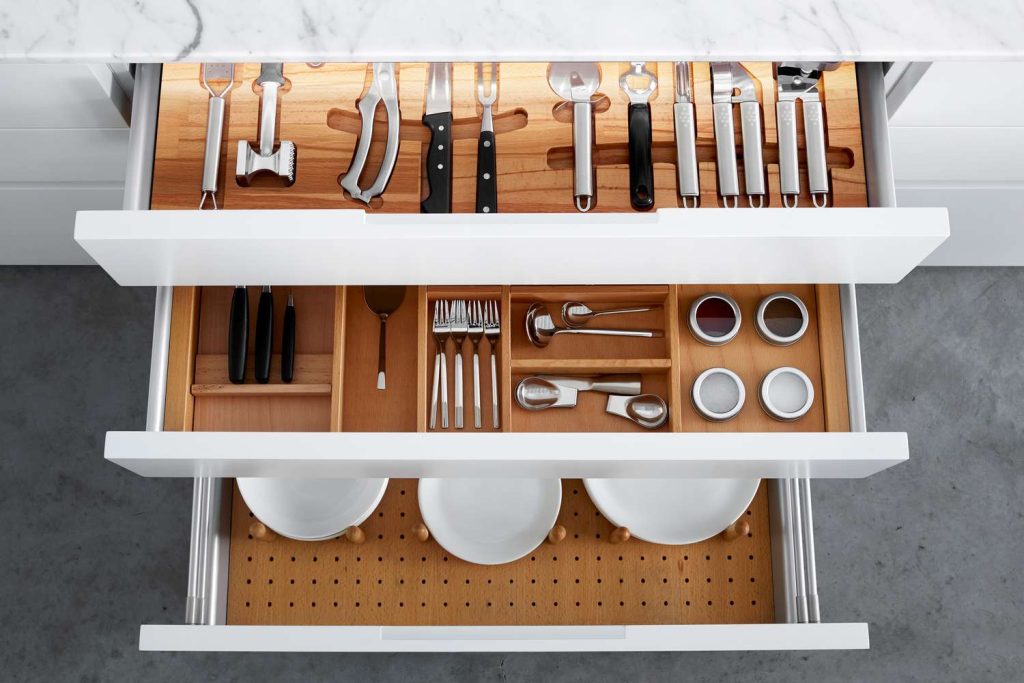
Organize the kitchen: that’s what matters!
Create uniformity
Storage jars are particularly suitable for a neat picture in the kitchen; you can pour everything into them loosely. Because even opened packages often leave a messy impression, it’s best to pour the leftovers into storage jars straight away.
Use every corner of the kitchen
There are many helpers that can be used to exploit even the smallest corners for so much stuff. These include:
- Lid holder
- Small shelves can be placed on the shelves to create storage space for dishes, small appliances and pots
- Stackable storage containers
- Hooks for cups, either on the open shelf or in the closet
- Wall organizer
Sort correctly
The rule is: Everything you need often goes to the front or where it is ready to hand. The rest? Can be further back in the closets, even in the unpleasant corners at the bottom and at the back (or you can use one of the following tricks…). If you want to eliminate the risk of confusion with storage jars, label them accordingly (“salt”, “sugar”). You cut out the cooking instructions from the packaging and stick them to the back of the glass using a transparent adhesive strip.
4 Tips and tools to keep things tidy
1. Separator
Lighter things tend to fall over in deep compartments. To prevent this from happening, install partitions or alternatively get clamping rods (actually for curtains) that you clamp between them! Also great for keeping boards under control!
2. Knife block
With a knife block you have all the important knives for cooking ready. A magnetic strip attached to the wall also creates order.
3. Rotating shelves
For many closets there are solutions for turning or unscrewing. Great for pots and pans!
4. Rollable utility carts
Wasted space between the next closet and the washing machine? You can use gaps with rollable carts for onion storage , storage containers, lids, etc.
Problem area open shelf
Not everyone has enough kitchen closets to accommodate everything. But things can quickly look chaotic on one or more open shelves, but that can also be remedied.
Organize the fridge
How can I properly store the refrigerator ? You can put everything in the fridge the way you want – but the layout in a fridge definitely makes sense. Because the compartments at the bottom are cooler (4° Celsius) than the ones at the top, which are around 12° Celsius.
Even more hacks and ideas for the kitchen
As you can see, there are a lot of tricks for using the space in the kitchen: whether with rotating trays to make it easier to get to things in the back of the closet, storing spices and cleaning supplies within easy reach and neatly in the drawers or using hooks to store bulky ones Getting a handle on pans.
FAQs
Q: How can I declutter my kitchen?
A: To declutter your kitchen, start by removing any items that you no longer use or need. Then, organize your kitchen items into categories and only keep the essentials.
Q: What are some tips for a clutter-free kitchen?
A: To maintain a clutter-free kitchen, regularly assess your kitchen items and get rid of anything unnecessary. Use storage solutions like drawer dividers and cabinet organizers to keep things tidy.
Q: Why is it important to declutter my kitchen?
A: Decluttering your kitchen can create a more functional and efficient space, making meal prep and cooking easier. It also reduces visual clutter, promoting a sense of calm and order in the kitchen.
Q: What is the best way to organize kitchen gadgets?
A: Store kitchen gadgets in easily accessible areas, such as cabinets or compartments near the food preparation area. Group similar items together and prioritize frequently used gadgets.
Q: Are there any printable kitchen decluttering checklists available?
A: Yes, there are printable kitchen decluttering checklists available online that can help guide you through the decluttering process, providing a step-by-step approach to organizing your kitchen.
Q: How can I create a minimalist kitchen?
A: To create a minimalist kitchen, focus on keeping only essential items and eliminating any unnecessary clutter. Utilize multi-functional tools and keep countertops and storage areas clear.
Q: What are some steps for decluttering my kitchen?
A: Start by emptying and cleaning each kitchen area, then categorize items into keep, donate, and discard piles. Organize what’s left and find storage solutions for easy access.
Q: What are some effective ways to maintain an uncluttered kitchen?
A: Regularly evaluate your kitchen items, utilize efficient storage solutions, and establish daily cleaning routines to maintain an uncluttered kitchen space.
Q: How can I organize my countertops and maximize counter space?
A: To maximize counter space, only keep essential items on the countertops and utilize wall-mounted storage or hanging racks for frequently used utensils and tools.
Q: What are the benefits of having a decluttered kitchen?
A: A decluttered kitchen promotes efficient meal preparation, reduces stress associated with visual clutter, and creates a welcoming environment at the heart of your home.
